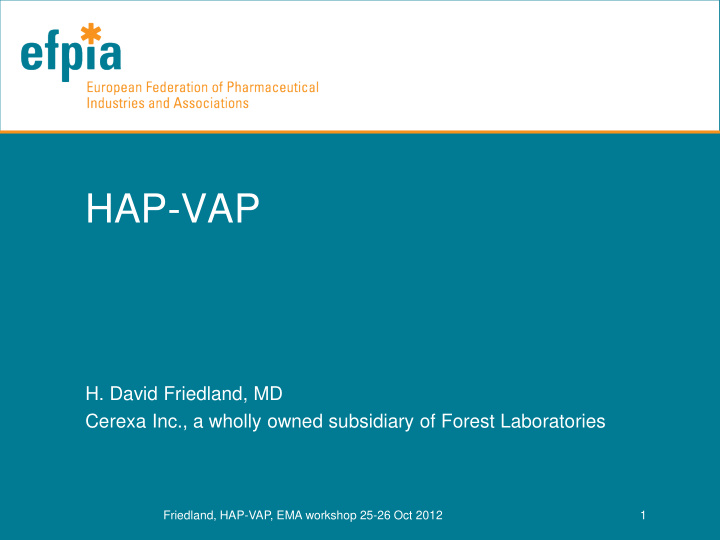



HAP-VAP H. David Friedland, MD Cerexa Inc., a wholly owned subsidiary of Forest Laboratories Friedland, HAP-VAP, EMA workshop 25-26 Oct 2012 1
Overview • Key points from previous workshop (Feb 2011) • Two new ideas not covered in the addendum • Other points from the addendum 2 Friedland, HAP-VAP, EMA workshop 25-26 Oct 2012
Key Points from Feb 2011 Workshop EFPIA: Inclusion of HAP and VAP in one study Addendum: • minimum of 30% VAP Further notes from EFPIA: • This may be impractical – Theravance study had 29% VAP (circa 2005-2007) – Incidence of VAP is decreasing • Preventative measures more ubiquitous 1,2,3,4 • In 2013 in US, ventilator-associated events reported by hospital; may affect pay-for-performance • EFPIA recommendation: set minimum at 25% 1 Bird D., et al. Arch Surg. 2010;145(5):465-470; 3 Morris AC, et al. Crit Care Med. 2011; 39:2218–2224 2 Koeman M, et al. Am. J. Respir. Crit. Care Med. 2006; 173(12): 1348-55; 4 Kollef MH. Surg Inf. 2011; 3(12):211-220 3 Friedland, HAP-VAP, EMA workshop 25-26 Oct 2012
Key Points from Feb 2011 Workshop NI margin up to 15% can be supported Addendum: • NI margin of 12.5% Further notes from EFPIA: • M1 is 29%, thus supporting higher M2 than 12.5% • Due to size and complexity, only one trial should be required; 12.5% is supported by EFPIA – E.g., Sample size will be 973 subjects • Assumes 80% cure rate for CE (45% evaluability), 90% power, 1-sided alpha of 0.025 [ITT population requires similar size] • If 2 studies are required, then 15% for each study should be acceptable – Sample size 680 subjects per study – 1360 subjects total 4 Friedland, HAP-VAP, EMA workshop 25-26 Oct 2012
Key Points from Feb 2011 Workshop EFPIA: Allow up to 24 h of prior antibiotics Addendum: • Supportive of up to 24 h of prior antibiotics EFPIA: Micro population should not be primary Addendum: • No specific mention of primary population(s) • Dec 2011 guideline states ITT and CE as coprimary Further notes from EFPIA: • We agree with the ideas in the Dec 2011 guideline 5 Friedland, HAP-VAP, EMA workshop 25-26 Oct 2012
Key Points from Feb 2011 Workshop EFPIA: Mortality (Day 14) only as secondary endpoint Addendum: • Day 28 mortality as secondary endpoint Further notes from EFPIA: • TOC could be before Day 28 – Could be clinical cure but still “failure” in secondary endpoint • Day 28 mortality good for safety assessment • Day 14 mortality is a better measure of efficacy – More contemporary to antibiotic therapy – Less “noise” due to comorbidities 6 Friedland, HAP-VAP, EMA workshop 25-26 Oct 2012
New ideas not covered in the addendum EFPIA: Initial concomitant study antibiotics • If new agent predominately Gram-negative – May need dual P. aeruginosa coverage – Will need Gram-positive coverage • If new agent predominately Gram-positive – Will need double coverage for P. aeruginosa – Gram-negative coverage likely to have overlapping gram- positive coverage • Result: monotherapy study drug against MRSA only – Need for mid-course adjustment based on culture results EFPIA recommendation: • Requirement for concomitant study antibiotics should not affect evaluability Friedland, HAP-VAP, EMA workshop 25-26 Oct 2012 7
New ideas not covered in the addendum EFPIA: Development of antibiotic for MDR pathogens • Using 12.5% margin requires 973 subjects • Only 25 MDR Gram-negatives enrolled – Assumes 33% ME, 40% G-neg pathogen, 20% MDR rate EFPIA recommendation: • Can we approach as add-on to “Tier B”? – Approval in another indication using standard NI studies (assumes study drug works equally well for non-MDR pathogens) – Non-statistically powered HAP/VAP study enriching for population of interest (e.g., a few hundred subjects) • Enrollment will be significantly slower (subject/site/month basis) – Restricted label for HAP/VAP (discussed yesterday) 8 Friedland, HAP-VAP, EMA workshop 25-26 Oct 2012
Other points from the addendum No mention of PRO for HAP/VAP • EFPIA: We agree – a PRO makes no sense here – Patients are intubated, critically ill, etc. Should HCAP be allowed? • Addendum seems to exclude – EFPIA: Could be excluding MDR pathogens (see CAP talk) Use of CPIS ≥ 6 as inclusion criterion for VAP • Addendum not clear if this is required for VAP or can be used if subject doesn’t meet other criteria Theravance studies: 32 – 57% subjects ≥ 6 (CE populations) – – CPIS use controversial; “CPIS has a limited role both clinically and as a research tool ” (Zilberberg and Shorr, CID 2012) EFPIA: CPIS ≥ 6 should not be a requirement for VAP • Friedland, HAP-VAP, EMA workshop 25-26 Oct 2012 9
Summary • EFPIA acknowledges the progress EMA has made with the new guidances • For broad spectrum agents, path forward is relatively clear – Caveats: concomitant study antibiotics should be allowed and not affect evaluability – Single trial should be adequate for HAP/VAP indication • For new agents targeting MDR pathogens, we need a different path forward – Proposal for “Tier B” approach: Treat HAP-VAP as one of the add-on site in a Tier B program Friedland, HAP-VAP, EMA workshop 25-26 Oct 2012 10
Recommend
More recommend